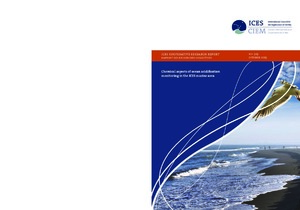| dc.contributor.editor | Hydes, David J. | |
| dc.contributor.editor | McGovern, Evin | |
| dc.contributor.editor | Walsham, Pamela | |
| dc.date.accessioned | 2019-12-28T13:51:32Z | |
| dc.date.available | 2019-12-28T13:51:32Z | |
| dc.date.issued | 2013 | |
| dc.identifier.citation | Hydes, D. J.; McGovern, E. and Walsham, P. (eds) (2013) Chemical aspects of ocean
acidification monitoring in the ICES marine area. ICES Cooperative Research Report,
No. 319, 78pp. DOI: https://doi.org/10.17895/ices.pub.5488 | en_US |
| dc.identifier.uri | http://hdl.handle.net/11329/1185 | |
| dc.identifier.uri | http://dx.doi.org/10.25607/OBP-702 | |
| dc.description.abstract | It is estimated that oceans absorb approximately a quarter of the total anthropogenic
releases of carbon dioxide to the atmosphere each year. This is leading to acidification
of the oceans, which has already been observed through direct measurements. These
changes in the ocean carbon system are a cause for concern for the future health of
marine ecosystems. A coordinated ocean acidification (OA) monitoring programme is
needed that integrates physical, biogeochemical, and biological measurements to
concurrently observe the variability and trends in ocean carbon chemistry and evaluate
species and ecosystems response to these changes. This report arises from an
OSPAR request to ICES for advice on this matter. It considers the approach and tools
available to achieve coordinated monitoring of changes in the carbon system in the
ICES marine area, i.e. the Northeast Atlantic and Baltic Sea.
An objective is to measure long-term changes in pH, carbonate parameters, and saturation
states (Ωaragonite and Ωcalcite) in support of assessment of risks to and impacts
on marine ecosystems. Painstaking and sensitive methods are necessary to
measure changes in the ocean carbonate system over a long period of time (decades)
against a background of high natural variability. Information on this variability is
detailed in this report. Monitoring needs to start with a research phase, which assesses
the scale of short-term variability in different regions. Measurements need to cover
a range of waters from estuaries and coastal waters, shelf seas and ocean-mode waters,
and abyssal waters where sensitive ecosystems may be present. Emphasis
should be placed on key areas at risk, for example high latitudes where ocean acidification
will be most rapid, and areas identified as containing ecosystems and habitats
that may be vulnerable, e.g. cold-water corals. In nearshore environments, increased
production resulting from eutrophication has probably driven larger changes in acidity
than CO2 uptake. Although the cause is different, data are equally required from
these regions to assess potential ecosystem impact.
Analytical methods to support coordinated monitoring are in place. Monitoring of at
least two of the four carbonate system parameters (dissolved inorganic carbon (DIC),
total alkalinity (TA), pCO2, and pH) alongside other parameters is sufficient to describe
the carbon system. There are technological limitations to direct measurement
of pH at present, which is likely to change in the next five years. DIC and TA are the
most widely measured parameters in discrete samples. The parameter pCO2 is the
most common measurement made underway. Widely accepted procedures are available,
although further development of quality assurance tools (e.g. proficiency testing)
is required.
Monitoring is foreseen as a combination of low-frequency, repeat, ship-based surveys
enabling collection of extended high quality datasets on horizontal and vertical
scales, and high-frequency autonomous measurements for more limited parameter
sets using instrumentation deployed on ships of opportunity and moorings. Monitoring
of ocean acidification can build on existing activities summarized in this report,
e.g. OSPAR eutrophication monitoring. This would be a cost-effective approach to
monitoring, although a commitment to sustained funding is required.
Data should be reported to the ICES data repository as the primary data centre for
OSPAR and HELCOM, thus enabling linkages to other related datasets, e.g. nutrients
and integrated ecosystem data. The global ocean carbon measurement community
reports to the Carbon Dioxide Information Analysis Center (CDIAC), and it is imperative
that monitoring data are also reported to this database. Dialogue between data
centres to facilitate an efficient “Report-Once” system is necessary. | en_US |
| dc.language.iso | en | en_US |
| dc.publisher | International Council for the Exploration of the Sea (ICES) | en_US |
| dc.relation.ispartofseries | ICES Cooperative Research Report; 319 | |
| dc.title | Chemical aspects of ocean acidification monitoring in the ICES marine area. | en_US |
| dc.type | Report | en_US |
| dc.description.status | Published | en_US |
| dc.format.pages | 78pp. | en_US |
| dc.description.notes | Authors: Alberto V. Borges ● Carlos Borges ● Naomi Greenwood ● Susan E. Hartman
David J. Hydes ● Caroline Kivimae ● Evin McGovern ● Klaus Nagel
Solveig Olafsdottir ● David Pearce ● Elisabeth Sahlsten
Carmen Rodriguez ● Pamela Walsham ● Lynda Webster | en_US |
| dc.description.refereed | Refereed | en_US |
| dc.publisher.place | Copenhagen, Denmark | en_US |
| dc.identifier.doi | https://doi.org/10.17895/ices.pub.5488 | |
| dc.subject.parameterDiscipline | Parameter Discipline::Chemical oceanography::Carbon, nitrogen and phosphorus | en_US |
| dc.subject.parameterDiscipline | Parameter Discipline::Chemical oceanography::Carbonate system | en_US |
| dc.description.currentstatus | Current | en_US |
| dc.description.sdg | 14.3 | en_US |
| dc.description.eov | Inorganic carbon | |
| dc.description.bptype | Best Practice | en_US |
| dc.description.bptype | Manual (incl. handbook, guide, cookbook etc) | en_US |
| obps.contact.contactemail | library@ices.dk | |
| obps.resourceurl.publisher | http://ices.dk/publications/library/Pages/default.aspx | en_US |
 Repository of community practices in Ocean Research, Applications and Data/Information Management
Repository of community practices in Ocean Research, Applications and Data/Information Management
